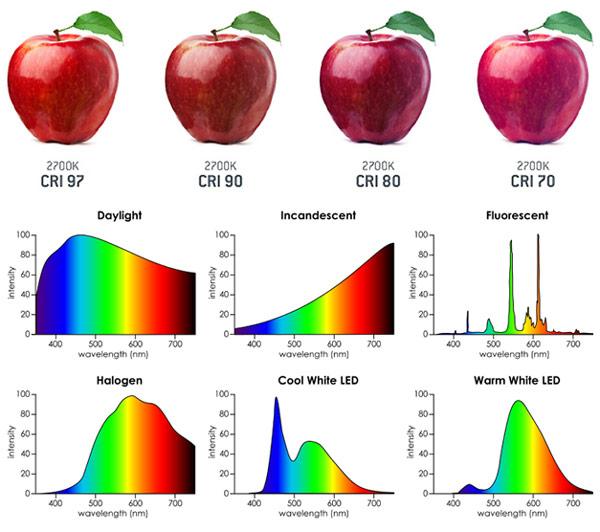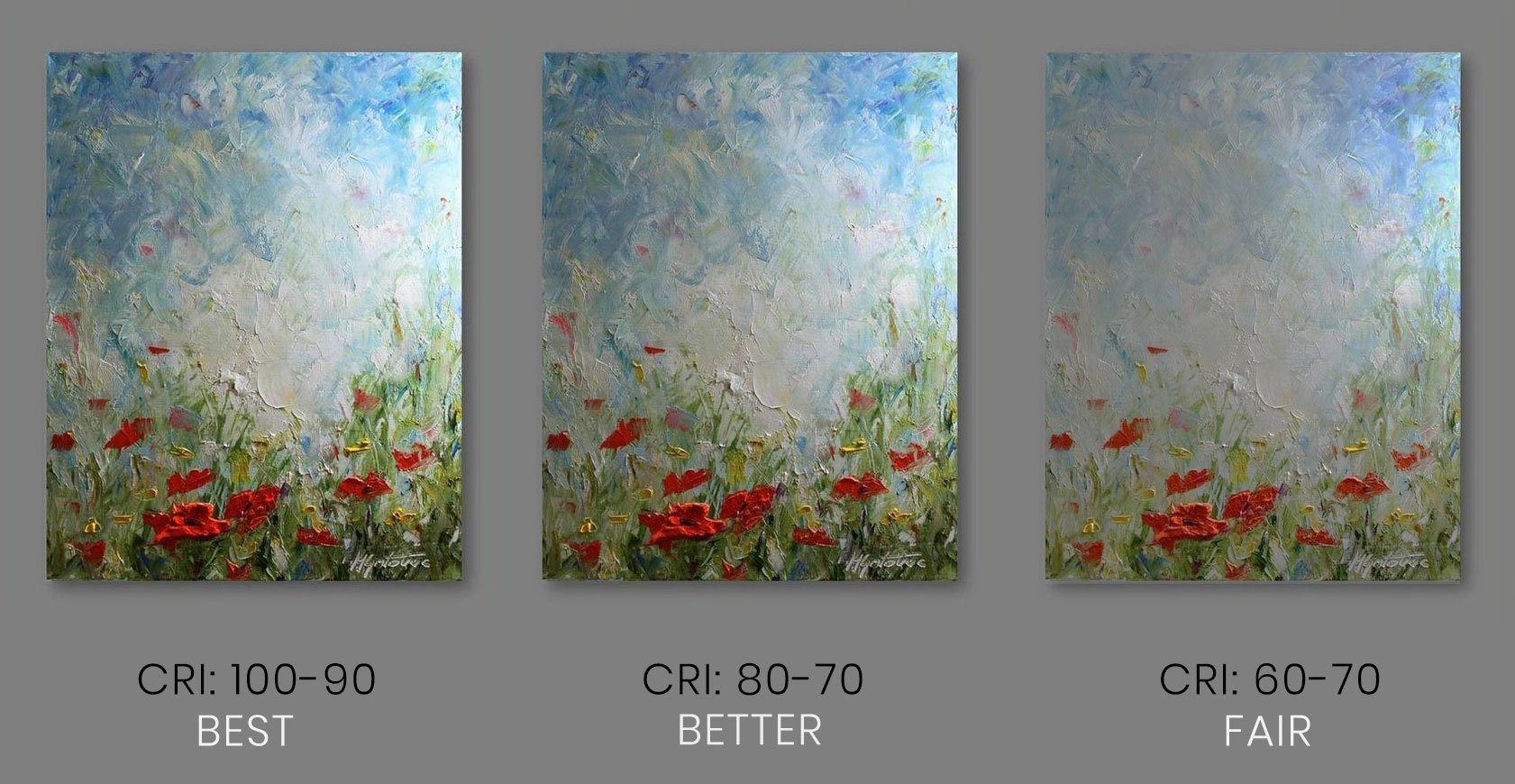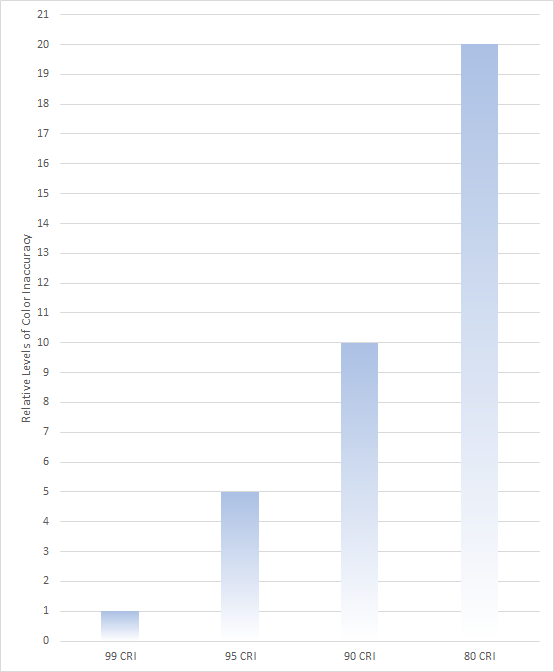Color Rendering Index (CRI) is an essential aspect of lighting design in both commercial and residential interior spaces. It measures how accurately a light source can reproduce colors compared to a reference light source, such as natural daylight.
A solid understanding of CRI can help interior designers create spaces that are not only visually appealing but also functional and comfortable for their occupants. In this article, we will explore the basics of CRI, its significance in interior design, and how to consider it when selecting light sources for various spaces.
Image: Theoretical illustration of the effect of color rendition on human complexion. Variations in wood tone are also notable.
What is Color Rendering Index (CRI)?
CRI is a quantitative measure of a light source's ability to accurately reproduce colors. It is represented on a scale of 0 to 100, with 100 being the perfect color rendering score.
Higher CRI values indicate better color fidelity, while lower values signify poorer color reproduction. Natural daylight has a CRI of 100, which serves as the reference point for all other light sources.
While CRI is applicable to all color temperatures, you will find it most applicable on white LEDs, with most modern LED decorative and architectural lighting offered in a CRI of 80 and above.
Why is CRI Important in Interior Design?
Color Accuracy: In interior design, accurate color representation is crucial for creating aesthetically pleasing spaces. High CRI lighting ensures that the colors of furniture, paints, walls, fabrics, and other design elements are perceived as intended, allowing designers to achieve their desired visual effects.
Enhancing Visual Comfort: Good color rendering helps reduce eye strain and makes it easier for occupants to perform tasks that require accurate color perception, such as design, reading, cooking, or working on a computer.
Mood and Atmosphere: The right lighting can significantly impact the overall ambiance of a space. High CRI lighting can evoke positive emotions and create a more inviting atmosphere, contributing to the occupants' well-being and satisfaction.
 Image: The wavelength range for different types of lighting. The higher CRI spectra will be closer to that of Daylight. Can you tell which one has the lowest CRI from these spectra?
Image: The wavelength range for different types of lighting. The higher CRI spectra will be closer to that of Daylight. Can you tell which one has the lowest CRI from these spectra?
Common CRI Values and Properties
CRI 95 - 100 → Exceptional color rendering. Colors appear true to life, subtle shades stand out and are accentuated, skin tones appear natural, artwork comes to life, and backsplashes and paint reveal their genuine colors.
Commonly used in film production sets, high-end retail stores, print and paint shops, boutique hotels, art galleries, and residential spaces where the accurate representation of colors is paramount.
CRI 90 - 95 → Excellent color rendering! Nearly all colors are vibrant and easily distinguishable. Outstanding lighting quality starts at a CRI of 90. Colors will appear striking, vivid, and fully saturated. Guests start to admire the countertops, paint, and details of your kitchen, but they might not realize that the lighting is primarily responsible for its stunning appearance!
CRI 80 - 90 → Good color rendering, where most colors are represented well. Suitable for most commercial applications. Items may not appear as fully saturated as desired.
CRI Below 80 → Lighting with a CRI below 80 is considered to have poor color rendering. Under such light, items and colors may appear washed out, dull, and occasionally indistinguishable (like struggling to differentiate between black and navy-colored socks). It becomes challenging to distinguish between similar colors.
 Image: High CRI lighting is particularly important for artwork where accurate color representation is essential.
Image: High CRI lighting is particularly important for artwork where accurate color representation is essential.
Selecting the Right CRI Value for Different Spaces
When choosing light sources for an interior design project, it's essential to consider the CRI value based on the intended use and function of the space:
Living Rooms and Bedrooms: In residential spaces like living rooms and bedrooms, a CRI of 80 or higher is recommended for general lighting. This ensures good color rendering, contributing to a warm and inviting atmosphere.
Kitchens and Bathrooms: For task-oriented spaces like kitchens and bathrooms, a CRI of 90 or above is ideal. This level of color accuracy makes it easier for occupants to perform tasks such as food preparation and personal grooming.
 Image: High CRI vs low CRI light source shows much greater saturation in vibrant materials like wood and fabric. The impact is still visible but not as dramtic on the blasted brick.
Image: High CRI vs low CRI light source shows much greater saturation in vibrant materials like wood and fabric. The impact is still visible but not as dramtic on the blasted brick.
Workspaces and Offices: In commercial environments, a CRI of 80 to 90 is suitable for most general and task lighting applications. Higher CRI values may be required for areas where color-critical tasks are performed, such as graphic design or art studios.
Retail Spaces: High CRI values of 90 or above are crucial in retail environments to accurately represent product colors, making them more appealing to customers and increasing the likelihood of sales. Diamond jewelry stores benefit from 95-100 CRI for brilliant illumination of diamonds and fine gemstones.
Restaurants and Dining: In restaurants and dining areas, a CRI of 80 or higher is generally recommended for creating a pleasant and inviting atmosphere. However, for areas where food presentation is essential, such as high-end establishments or open kitchens, a CRI of 90 or above may be more suitable to showcase the true colors and textures of the dishes.
Hotels and Hospitality: CRI values should be tailored to the specific needs of each space. For guest rooms and suites, a CRI of 80 or higher is recommended to create a comfortable and inviting atmosphere. In public spaces like lobbies, restaurants, and conference rooms, a CRI of 90 or above is ideal to ensure accurate color representation and create a high-quality, luxurious experience for guests.
Art Galleries and Museums: In spaces where artwork and exhibits are showcased, exceptional color rendering is crucial. A CRI of 95 or higher is recommended to bring out the true colors, textures, and details of the art pieces, allowing visitors to fully appreciate and engage with the displays.
 Image: Relative color accuracy for common lighting CRI values.
Image: Relative color accuracy for common lighting CRI values.
Summary
Understanding the basics of CRI and its significance in interior design is essential for creating visually appealing and functional spaces. By carefully considering the CRI value of various light sources, interior designers can enhance the overall aesthetics, visual comfort, and atmosphere of both commercial and residential spaces. If you need help finding the right specifications for your project, our family of lighting experts is here to help.
Additional Resources on Color Rendering Index
Optica.org : This webinar, hosted by the OSA Color Technical Group, will begin with a description of the theoretical and practical considerations that are important when characterizing how light sources render object colors. Our presenters, Kevin Houser and Michael Royer, will then describe TM-30-18: IES Method for Evaluating Light Source Color Rendition, including the characterization of average color fidelity and color gamut, and hue-specific changes in chroma, hue, or fidelity.
Energy.gov : Since 2015, DOE has conducted research to measure subjective evaluations and preferences for different color rendition conditions, with a goal of providing lighting manufacturers and specifiers with more complete information to effectively balance color quality and energy efficiency in a variety of lighting applications.
Nist.gov : A Color Quality Scale (CQS) is being developed at NIST with input from the lighting industry and the CIE (International Commission on Illumination) to address the problems of the CIE Color Rendering Index (CRI) for solid-state light sources and to meet the new needs of the lighting industry and consumers for communicating color quality of lighting products.
Energystar.gov : The color rendering index (CRI) has been used to compare fluorescent and HID lamps for over 40 years, but the International Commission on Illumination (CIE) does not recommend its use with white light LEDs. A new metric is under development. In the meantime how should we use CRI when it comes to LEDs?
T&FOnline.com This study was conducted to investigate Color Rendering Index (CRI) recommendations for light emitting diode (LED) lighting in spaces needing better color rendition.

